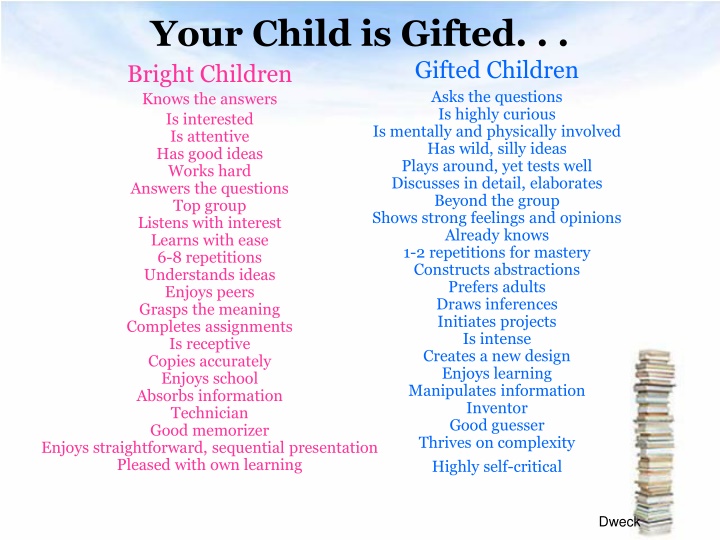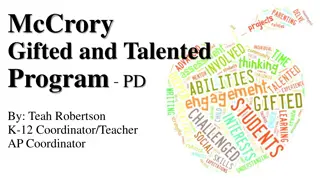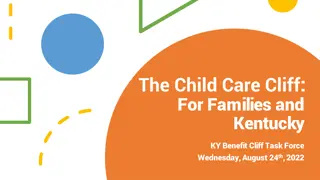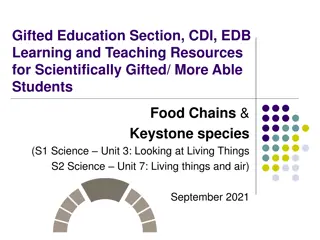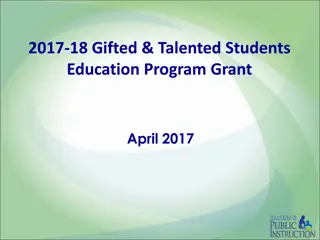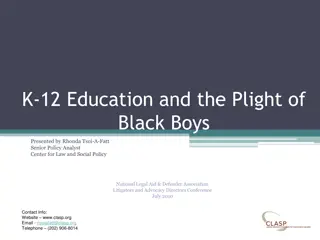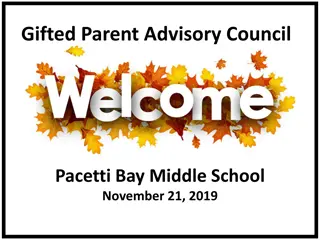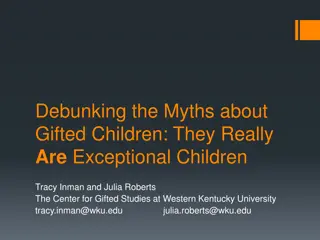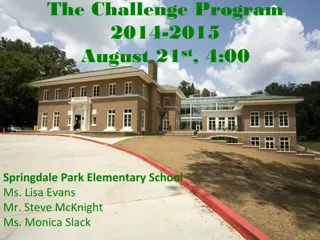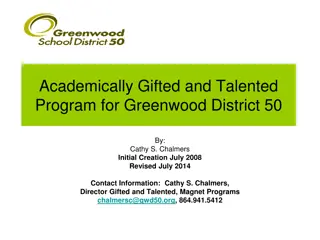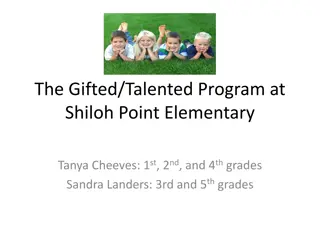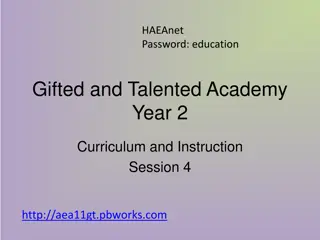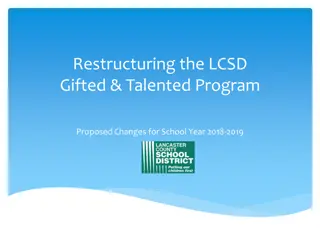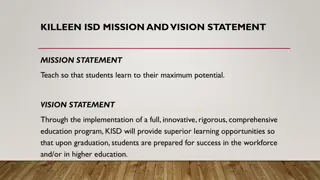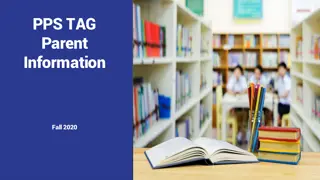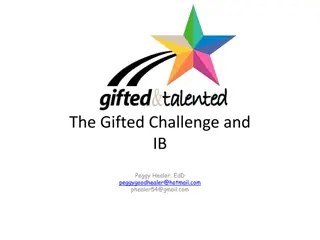Your Child is Gifted. . .
Gifted children exhibit unique characteristics such as curiosity, strong opinions, and intense involvement. They thrive on complexity and enjoy learning. This content explores the traits of gifted children and provides insights into their educational needs, including classroom activities and grading practices. Emphasis is placed on promoting self-reflection and ownership of learning through clear goals and scales.
Download Presentation

Please find below an Image/Link to download the presentation.
The content on the website is provided AS IS for your information and personal use only. It may not be sold, licensed, or shared on other websites without obtaining consent from the author.If you encounter any issues during the download, it is possible that the publisher has removed the file from their server.
You are allowed to download the files provided on this website for personal or commercial use, subject to the condition that they are used lawfully. All files are the property of their respective owners.
The content on the website is provided AS IS for your information and personal use only. It may not be sold, licensed, or shared on other websites without obtaining consent from the author.
E N D
Presentation Transcript
Your Child is Gifted. . . Gifted Children Asks the questions Is highly curious Is mentally and physically involved Has wild, silly ideas Plays around, yet tests well Discusses in detail, elaborates Beyond the group Shows strong feelings and opinions Already knows 1-2 repetitions for mastery Constructs abstractions Prefers adults Draws inferences Initiates projects Is intense Creates a new design Enjoys learning Manipulates information Inventor Good guesser Thrives on complexity Highly self-critical Bright Children Knows the answers Is interested Is attentive Has good ideas Works hard Answers the questions Top group Listens with interest Learns with ease 6-8 repetitions Understands ideas Enjoys peers Grasps the meaning Completes assignments Is receptive Copies accurately Enjoys school Absorbs information Technician Good memorizer Enjoys straightforward, sequential presentation Pleased with own learning Dweck
Welcome to Curriculum Night Community and Collaboration 2019-2020
Introductions Mrs. Megan Bush Mrs. Kelly Heitic Ms. Nicole Roselius Dr. Tara Zichichi
A Day in the Life of a 2nd Grader Daily Schedule 9:00-9:40 Morning Work/Fundations (Homeroom teacher) 9:40-10:40 Math (Weekly Rotations with all 4 teachers) 10:40-11:00 Recess 11:00-11:20 Read Aloud (2 groups with 2 teachers) 11:20-11:50 Tribes (Daily Rotations) Social Emotional - Dr. Zichichi Research- Mrs. Heitic ELA - Ms. Roselius Writing- Mrs. Bush 12:00-12:40 Lunch 12:40-1:50 Integrated Studies (Rotations with all 4 teachers) 2:00-2:40 Specials (Homeroom) 2:40-3:10 Book Club (All 4 teachers, student choice) 3:10-3:40 End of the Day routine (Homeroom)
Grading Please check your child s Infinite Campus portal for grades throughout the quarter. We believe your child is the perfect version of themselves, and they are learning and growing. We believe we learn from our mistakes, so we are free to make them. We are here to challenge gifted learners!
Purpose of Scales Why use learning goals and scales: Student performance increases when learning goals are clear. Monitoring progress through the use of specific scales enables students to self-reflect and take ownership of their learning. Clear goals and scales are helpful for providing specific feedback. (https://www.cusd80.com/Page/40488) Our desire in 2nd grade is to provide parents with the most accurate representation we can of their student's learning. Learning scales can help parents see a concrete progression of skills. We go over these scales with students prior to projects and assignments so they know what their goal is. Students are learning how to accept feedback and know that feedback is information. We want students to develop a growth mindset and understand that a 3 means they are still working towards meeting a learning target/goal, and that is okay. Students are learning that feedback is information that helps us learn and grow. We also want students to understand that while a 4 meets the learning target, we always encourage them to "strive for five" when thinking about their learning goals.
Academic Scales 3.OA.A Represent and Solve problems involving whole number multiplication and division Interpret products of whole numbers as the total number of objects in equal groups (e.g., interpret 5 x 7 as the total number of objects in 5 groups of 7 objects each). Interpret whole number quotients of whole numbers (e.g., interpret 56 8 as the number of objects in each group when 56 objects are partitioned equally into 8 groups, or as a number of groups when 56 objects are partitioned into equal groups of 8 objects each). Use multiplication and division within 100 to solve word problems in situations involving equal groups, arrays, and measurement quantities. Determine the unknown whole number in a multiplication or division equation relating three whole numbers For example, determine the unknown number that makes the equation true in each of the equations 8 x__ = 48, 5 = __ 3, 6 x 6 = __ 3 OA.A.1 3 OA.A.2 3 OA.A.3 3 OA.A.4 3 OA.A.1 Learning Target Scoring Guide 3 (Approaching the Learning Target) 4 (Meets the Learning Target) 5 (Extending the Learning Target) Student interprets products of whole numbers as the total number of objects in equal groups, creates a mathematical model that represents the mathematical elements and the relationship among them, composes and decomposes mathematical ideas and notations into familiar relationships and consistently evaluates the reasonableness of his/her results. Student interprets products of whole numbers as the total number of objects in equal groups with prompting and support. Student interprets products of whole numbers as the total number of objects in equal groups.
Behaviors for Learning Scales 3 (Approaching the Learning Target) 4 (Meets the Learning Target) 5 (Extending the Learning Target) With prompting and support, Student: Actively listens and participates. Makes good use of time by working independently and/or cooperatively. Completes classwork as assigned. Practices self-discipline. Without teacher prompting and/or support most of the time, Student: Actively listens and participates. Makes good use of time by working independently and/or cooperatively. Completes classwork as assigned. Practices self-discipline. Without teacher prompting and/or support all of the time, Student: Actively listens and participates. Makes good use of time by working independently and/or cooperatively. Completes classwork as assigned. Practices self-discipline. Purpose for Behaviors of Learning Scales: Students are still developing executive functioning skills, learning how to adapt to different environments, and collaborate with others. All of these behaviors have a direct impact on their academic and social emotional development.
KGA 7 Cs Cogitate The ability to generate many ideas as well as adding details and extending ideas Collaborate Sharing ideas, honoring perspectives of others Communicate Using I Messages, appropriate tone and word choice Calculate Includes effective planning and implementation Craft Working to develop attention to detail Construct Creating, building, composing Connect Making real world applications
Fixed Mind Set vs. Growth Mind Set Fixed Mind Set Intelligence is a fixed trait You need to look smart at all costs. Effort is bad; it should come naturally. Setbacks- blame others, hide mistakes; conceal deficiencies. Growth Mind Set Intelligence is a quality that can be developed. Learn at all costs Effort is key; work hard. Setbacks-Capitalization mistakes; confront deficiencies. Dweck,2006 Dr.Beljan Psychological Services, 2014
Building Community and Collaboration Behavior Management Plan We will be implementing TRIBES to foster a positive, cohesive, safe and cooperative learning environment for your child. There are five main principles whose purpose it is to create a classroom community where each student is valued, respected and empowered. Attentive Listening Appreciation/ No PUT DOWNS Right to Participate Mutual Respect Safety First
Keeping in Contact Website - Weekly Blog Facebook- KGA 2nd Grade Remind- code is @kga2n Instagram- kga2nd
Communication Policy Open communication is of utmost importance to us in our desire to build a collaborative partnership with parents. The best way to contact us is through email. However short concise emails will help us address your concern without taking away from our planning time for your child s education. We will respond to emails and phone calls as soon as possible. We do NOT respond do emails after 4 p.m. on weekdays and we do NOT answer on the weekends. Please email ALL four teachers, but you will only receive a response from one teacher, on behalf of the team.
Homework Each quarter, students are assigned a long term, student choice project called You Be the Expert. These projects are aligned to our science and social studies standards. They are designed to help students develop executive functioning skills and presentation skills. There will be progress check-ins that we record as their homework grades. You Be the Expert check-ins are organized so that students can complete them during a homework time that works best for the student during the week. Homework is a behavior for learning and does not impact a student s academic grade.
How PARENTS can support Extended-Learning Opportunities through Curriculum-Supported Field Trips For each trip, chaperones are randomly drawn in front of the 2nd grade community. Per district policy, only chosen chaperones are able to attend field trips. Field trips for this year are to be determined. Tax Credit Donations (in any increment, up to $400/married couple)
Volunteering Opportunities Include: Weekly Copies At-Home Prep (Scholastic Book Orders) Weekly Guest Reader Design Build Projects/Science Experiments Class Celebrations There will be a sign-up genius on our website. Per district policy siblings are not permitted on campus during the school day.
Birthday Policy We enjoy celebrating with your child as they celebrate his/her birthday. If you would like to donate a classroom treat, please deliver those items to the front office. We typically celebrate with our homeroom during our morning recess. Treats must be store bought. We are a nut free classroom.
Services Provided When to contact me Kindness Lessons (whole class) Changes in your family circumstances (i.e. death, moving, illness, accident, addiction, divorce) MRS. PAULA DESANTIS KGA COUNSELOR 480-812-6106 DESANTIS.PAULA@CUSD80.COM Small groups (during lunch) If you have a question about supporting your child s social and emotional well-being Individual support 504 support, any concerns or question about you students Kindness Kounts at KGA!
Thank you for attending Curriculum Night! We look forward to an amazing school year!
